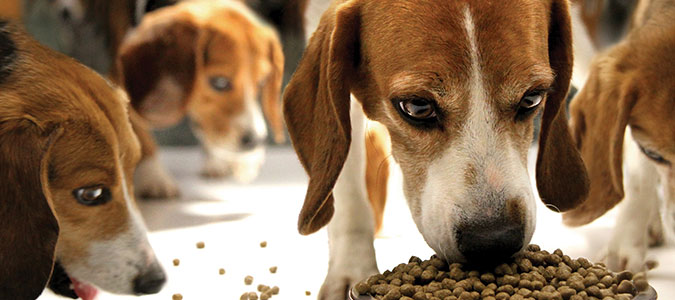Bye-bye beagles
Lynn Weber sent out a simple email in mid-November asking if anyone was interested in adopting a beagle. What she was unprepared for was the overwhelming response.
By Kris Foster
"It went viral," said the associate professor in the Department of Veterinary Biomedical Sciences. "I started getting emails from Alberta, Ontario, everywhere. Let's just say that I had so many phone calls and emails that handling them became a full-time job. I didn't expect that kind of response."
The beagles that needed homes were part of Weber's three-year nutrition study at the Western College of Veterinary Medicine (WCVM). They had become a common sight on campus when all eight were out for their daily walk with Weber, a veterinary student or a volunteer managing a fist full of leashes. The dogs, all named for Charles Schultz Peanuts characters, were even featured in an award-winning U of S print ad in
University Affairs magazine.
Weber put together profiles for each of the dogs needing homes—Peanut, Lila, Lucy, Sally, Patty and Linus—that included birthdates, photos and descriptions of their unique personalities. (She started the study with 10 beagles; two were adopted earlier due to health problems unrelated to the study and two were spoken for before the study ended.) She emailed the request for people to take the dogs to her colleagues in the WCVM "but most of us deal with strays so often that the response rate is low." It was when she sent the email to two collaborators in the College of Agriculture and Bioresources that it really took off.
Nothing gets the word out like Facebook, and soon Weber had more than enough prospective adopters but to find the right homes for the beagles took some work. "I do a bit of a screening," she said, "asking if people have experience with dogs, if they have yards, but a lot of it's gut feeling. I can actually tell quite a bit from two lines in an email," including how to identify the "whackos" of which there were a few.
Weber then did personal interviews with the adoptive families before introducing them to the beagles. There was a natural bonding that took place—the dogs and owners picked each other. "At one point, I had four groups of potential owners and four dogs so I let everybody loose in a room together."
By the end of November, the beagles all had new homes, all in Saskatoon. Weber said she didn't cry when the dogs left but her PhD student and technician both did.
Cute and loveable as they were, the beagles also proved to be excellent subjects for Weber's study that looked at whether dried field peas were a healthier carbohydrate in dog food than rice. The findings are important, she said, "because dogs are just as fat as humans are—30-50 per cent of pets are obese."
By carefully feeding the dogs formulated diets, Weber got them fat by 12 weeks into the study, then found they did not lose weight on either the field pea or rice diets. What she observed, though, was that the dogs on the field pea diet fared better in terms of insulin levels, ability to handle glucose and levels of belly fat—"they did better on the pea diet; it was making them healthier."
Her most interesting finding was that the weight the dogs gained in two weeks took them almost three months to shed. "Their metabolism had changed," said Weber. "They were holding onto every ounce of fat, and that's bad news for those of us who are dieting."
The dogs were back to normal weight for the final eight months of the study but the last of Weber's measurements on them have not yet been analyzed. "The important question is, are beagles a superior model for studying obesity? All the tests you can do on humans we can also do on dogs, and that isn't always the case with rodents."
And for those who already miss seeing the beagles out for their walk, 10 more will be arriving in the spring when Weber expects to start a new carbohydrate study to compare a number of different lentils with corn. Although they will not be out for walks, that study will also involve 10 cats and thousands of fish.

